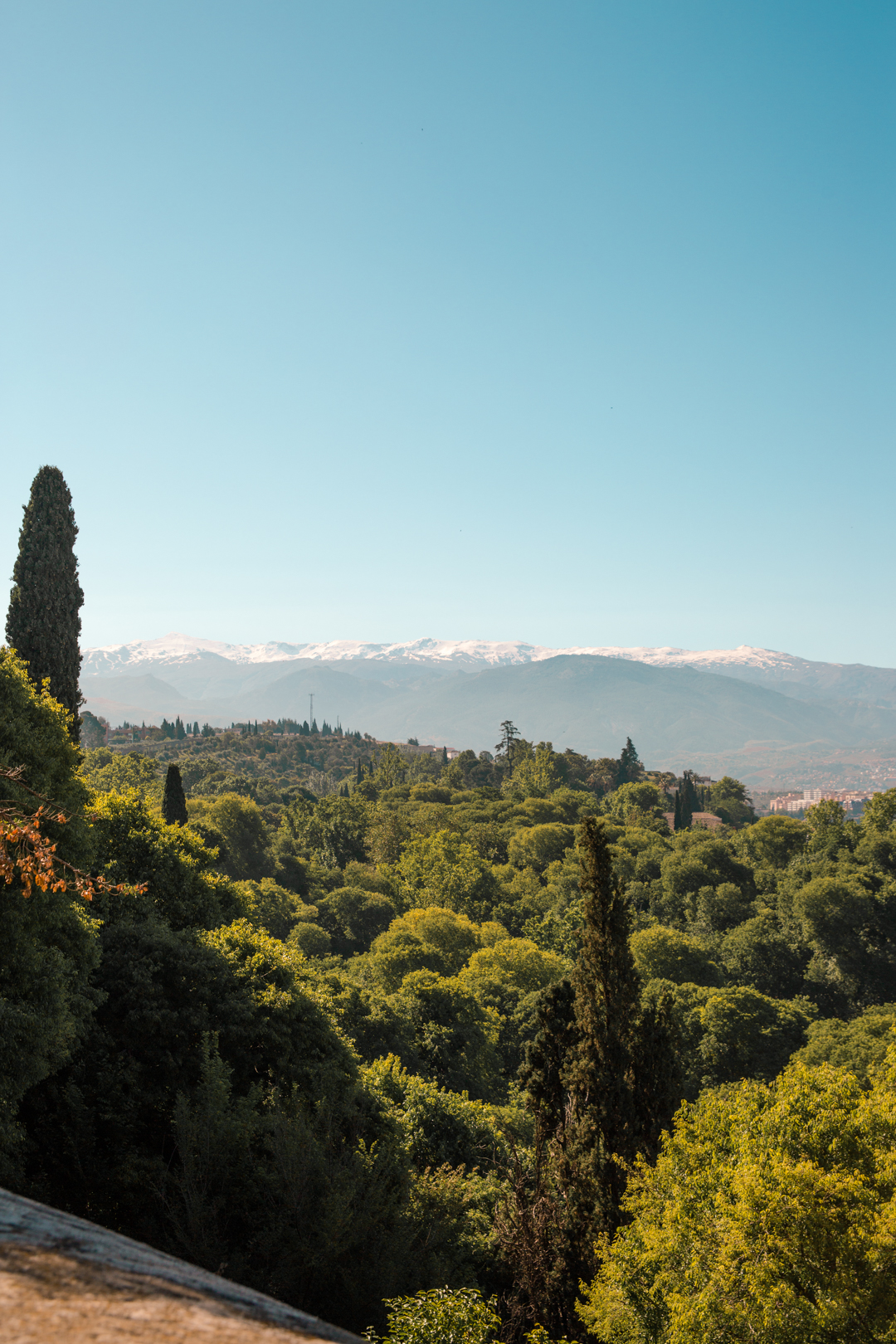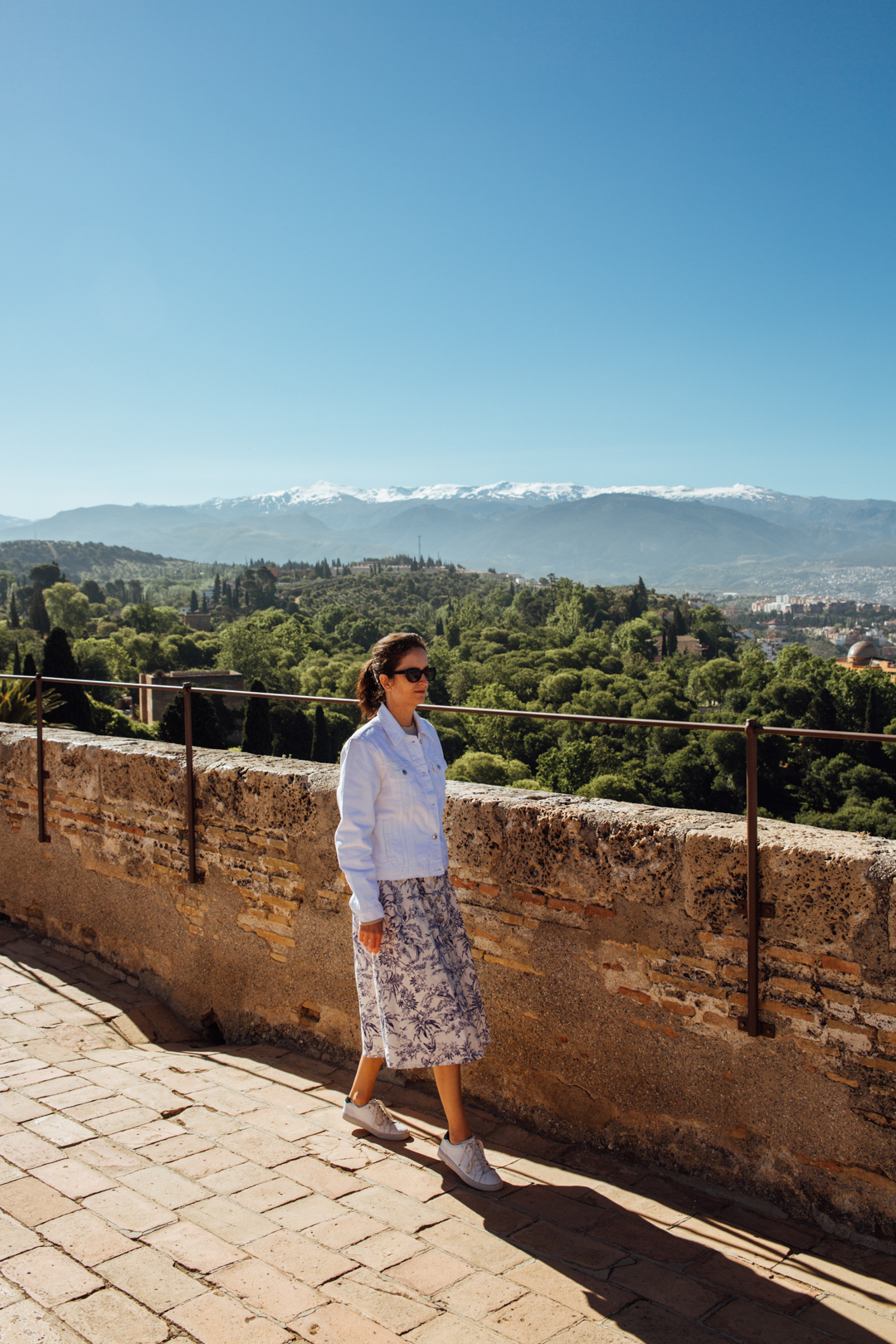Does it snow in Spain?
If you want a short answer – yes, it does!
The long answer: it depends on where you go and when you go. This article will provide an in-depth overview of where in Spain you can go chasing your winter wonderland.
I’ve been living in Southern Spain since 2020, so I have personally not experienced any snowy days down here, but have visited cities that are a getaway to winter resorts, like Granada.
Read on to find out more!
Snow in Spain
When you think of a getaway to Spain, chances are you imagine a typical Mediterranean climate with sun-soaked beautiful beaches, palm trees gently blowing in the breeze and delicious tapas plates.
While the tapas are indeed delightful, Spain isn’t always all sunny days, with balmy weather in the wintertime.
The Iberian Peninsula has many different regions, all of which experience different climates and weather patterns. Its geography includes coastal areas, inland plains, and even mountainous areas.
So, does it snow in Spain?
While regions like the iconic Costa del Sol, Canary Islands, or the Balearic Islands are famous for their perfect weather and sandy beaches, parts of Spain experience cold weather, rain, and even heavy snowfall in various regions.
The nation’s diverse geography also means a diverse forecast, and quick changes in average temperatures, so it’s important to be aware of weather possibilities before planning a trip.

The Geographical Overview of Spain
Bordering France to the east and Portugal to the west, Spain is part of Europe’s Iberian Peninsula.
The country has two major coastlines: one along the Mediterranean Sea and one overlooking the Bay of Biscay in the North of Spain. Altogether, the country’s coastline measures over 5,750 kilometers, or over 3,570 miles. Spain’s high altitude makes it one of the continent’s most elevated countries.
The country’s topography includes desert-like landscapes, volcanic zones, mountain slopes, woodlands and plenty of inland bodies of water.
Along with various coastal regions, Spain is home to mountain ranges like the Pyrenees, Cantabrian, and Sierra Nevada. Areas at a lower elevation include plateaus like the Meseta, a dry region in the heart of the country.
Spain’s climate zones are the Mediterranean, continental climate, oceanic climate, mountain and arid zones. Much of the country sits within the continental zone, which can experience winter snowfall in higher altitudes, springtime rain and even wet summers.
Southern Spain coastal regions are in the Mediterranean zone, which has milder winters and hot summers.
The Atlantic Ocean brushes over Spain’s northern coastline, which sees high amounts of rain and less dry summers. Mountain climates are generally colder and see the heaviest snowfall, while the nation’s southeastern arid zone is very dry.

Where Exactly Does it Snow?
So, where exactly does it snow in Spain? What are the best places to experience snowfall in Spain?
Much of the country’s snowfall is concentrated in mountainous regions like the Sierra Nevada and Pyrenees.
Sierra Nevada Mountains
Located just west of the southern city of Granada, the Sierra Nevada Mountains are a year-round destination. Home to a national park preserving the fauna, flora, and landscape of this alpine zone, the mountains are a popular destination for the winter season and known for their winter sports.
Visitors often stay at the Sierra Nevada Ski Resort, which is located on Pico de Veleta. As one of Spain’s highest peaks, and one of the best ski resorts, the mountain offers plenty to do in the winter and is conveniently close to the cultural hub of Granada. The resort is known for its high-altitude slopes and has played host to various professional ski events.
The ski season in the Sierra Nevadas lasts about five months. The region generally sees snow between November and May, but early January, February and March are recommended for the best skiing conditions.
The Pyrenees
Located along Spain’s border with France, the Pyrenees Mountains are another top winter weather destination. Visitors can enjoy ski slopes, sledding, snowboarding and even snowshoeing on trails throughout the region. The Pyrenees are easy to reach from Barcelona and can make an easy weekend addition to a stay in the city. Buses and shuttles are available between the two destinations.
You’ll also get to soak in plenty of Catalonian cuisine and culture while visiting mountain villages along the way. January and February are prime skiing months, but the season generally starts in November and lasts until late winter.
Central Plateau
While Spain’s central plateau isn’t as much of a winter sport destination as the nation’s alpine regions, it still sees snowfall from time to time. Known as the Meseta Plateau, the area covers much of central Spain and experiences cold winters than coastal areas.
High snowfall isn’t always guaranteed and varies from year to year. However, it’s not uncommon- Madrid does sometimes get light snow in mid-winter. While it is possible, snowfall likely won’t be high enough to constitute a blizzard.
When to Expect Snow
While weather can be unpredictable, it’s important to have an idea of what to expect before planning a trip to Spain. The tips below can help you arrange your getaway, especially if you’re considering visiting in the wintertime.
Spain usually sees snowfall between December and April. This means that a summer or fall trip likely won’t be affected- however, keep in mind that the autumn does see more rain than other times of year. January is often the coldest and snowiest month in various regions across Spain.
While central Spain doesn’t often see blizzards, anomalies are possible- take the 2021 Filomena snowstorm, for example. The storm took the city of Madrid by surprise, blanketing the capital in over a foot and a half of snow. If there is an atypical weather pattern in the forecast, it may be best to plan your trip around it instead of taking a risk.
The Cultural Impact of Snow
Winter has cultural significance in various cultures, and Spanish culture is no different. Many celebrations join Сhristmas, including the Feast of the Immaculate Conception, The Verdiales festival, New Year’s Day, and even winter solstice bonfires.
While snow isn’t a major part of Spanish culture, an especially snowy season can impact anything from local agriculture to tourism. Snowfall can snarl transportation, making tourist sites difficult to access during storms. Train, plane and bus service can be impacted by weather conditions.
Common Myths Busted
Like any iconic destination, the idea of Spain comes with common myths that are often dispelled once you actually visit the country.
– “It never snows in Spain!”
It’s simply not true that it never snows in Spain. The country’s highest peaks and slopes are covered in snow every winter, allowing the ski season to thrive. The middle of the country sees snow occasionally. As seen by the example of storm Filomena, Spain is susceptible to unpredictable weather, including snowfall.
– “Snow in Spain is bad for the tourism industry.”
This is a common misconception that you will forget about as soon as you visit a Spanish ski resort. In the winter months, mountain resorts and ski lodges are bustlined with both international visitors and local enjoying hot drinks before heading back out to enjoy the winter wonderland.
While regions like the beachy Сosta del Sol are not as popular during colder months, the Pyrenees and other mountain ranges become top destinations.
Winter in Spain: Travel Tips
If you love winter weather and are looking to experience a snowy Spain, consider planning your trip for January or February. These are the country’s snowiest and coldest months, so be sure to bundle up.
Snowy activities
Winter activities across the country range from skiing and snowboarding to sledding and snowshoeing. Many winter venues may also offer ice skating. A good old snowball fight or snowman- building session can always brighten up your trip as well!
What to pack
It’s crucial to pack accordingly when planning a winter getaway. The last thing you want is for your trip to be interrupted by runs to the store to pick up items you’re missing. Your cold weather packing list should include plenty of layers, including leggings, long sleeve shirts, thick socks, and a packable but warm-down jacket.
A hat, waterproof gloves, and a scarf are also staples. Be sure to bring along a pair of warm waterproof shoes so that you can be comfortable while exploring in the snow or rain. Lined waterproof boots are a good idea. Take along an umbrella just in case and consider bringing along a few pocket hand warmers and a portable thermos so that you can carry a hot drink with you.
While we don’t immediately associate Spain with snowfall, its presence is inevitable. By knowing the facts beforehand, you can plan your trip around winter weather- or embrace it and experience the best of Spain’s off-season. The country’s sunny and snowy seasons are both worth getting to know, and when you visit depends largely on the regions you are curious about.
Ski Resorts In Spain
Let’s take a short tour of some of the best skiing resorts in Spain!
1. Baqueira-Beret
Location: Val d’Aran, Pyrenees
Why Visit: This is basically the Rolls Royce of Spanish ski resorts. It’s the largest and most visited ski resort in Spain. Expect top-notch facilities, amazing powder, and a variety of slopes for all levels.
2. Sierra Nevada
Location: Granada, Andalusia
Why Visit: So how does skiing in the morning and hitting the beach in the afternoon sound? Yep, Sierra Nevada makes it possible. It’s super close to the Mediterranean coast. Plus, it’s one of the highest ski resorts in Europe, which often means a longer ski season.
3. Formigal-Panticosa
Location: Huesca, Aragón
Why Visit: It’s actually two resorts combined into one, offering a whopping 176 kilometers of slopes. This place is perfect for families and groups with mixed levels of experience.
4. La Molina
Location: Girona, Catalonia
Why Visit: This is one of the oldest ski resorts in Spain, but don’t let that fool you. It’s been updated with modern facilities and offers a cozy, family-friendly atmosphere. It’s also just a couple of hours from Barcelona, so you can mix city life with mountain action.
5. Cerler
Location: Huesca, Aragón
Why Visit: Nestled in the Pyrenees, Cerler boasts some of the highest peaks in the range. Expect stunning views and a good mix of slopes for beginners and pros alike. It’s less crowded than other big-name resorts, which means more space for you.
6. Candanchú
Location: Huesca, Aragón
Why Visit: This one’s an oldie but a goodie. It’s actually the oldest ski resort in Spain, and it has a classic, vintage vibe. The resort is near the French border, and it offers a variety of slopes for all levels.
7. Alto Campoo
Location: Cantabria
Why Visit: If you’re into something a bit off the beaten path, check out Alto Campoo. It’s smaller than the other resorts but offers a unique experience with fewer crowds and beautiful natural landscapes.
Frequent Questions about Snow in Spain
What part of Spain does it snow?
In theory, it can snow almost anywhere in Spain, but snowfall is mostly found in the biggest mountain ranges of the Pyrenees and Sierra Nevada, but also in the Northern regions of Spain and inland. A few years ago there was a historic event when a heavy snowfall surprised residents even in the capital of Spain – Madrid.
Has it ever snow in Spain?
Yes, it does snow in Spain. Snow is most frequently found on the slopes of the Pyrenees, which is the mountain range on the borders between Spain and France. Snow is also a common sight in Sierra Nevada and some inland areas, and Northern Spain.
When did it last snow in Spain?
The last significant snowfall was recorded in Spain in January 2021, when a heavy snowfall surprised the residents of Madrid. Snow is a regular occurrence in Spain, particularly in the mountain regions of the Pyrenees and Sierra Nevada.
What cities does it snow in Spain?
The cities that get snow in Spain are for example the cities on the foothills of the Pyrenees, but snow is not uncommon for inland areas. For example, in January 2021, residents of Madrid woke up to a heavy snowstorm brought by the storm Filomena.
Where is it the coldest in Spain?
Calamocha, Teruel, Aragón is one of the coldest places in Spain, with the city of Monreal del Campo twice recorded temperatures of −28° C in December.
Is Spain very cold in winter?
Spain can be cold in winter, but not as cold as the rest of Europe. The further south you go, the milder winter you will experience. On Costa del Sol, for example, you can expect temperatures around 10C and the temperatures rarely go below zero, even at night.
What is the coldest month in Spain?
January is considered to be the coldest month in Spain, and that’s true no matter where you go, even in the south. While the temperatures in the South of Spain are higher than average, you experience heavy rains and wet weather in the South.
How long is winter in Spain?
Winter in Spain lasts from mid to late December to March. The winter temperatures in Spain are much milder compared to Europe but can have big differences in temperatures. For example, the North of Spain will be much colder compared to the south of the country.
Which city in Spain is best in winter?
Malaga or Granada are the best cities to visit in the wintertime. They experience mild winters, and if you visit at the beginning of the winter season, you will be treated to very pleasant weather with lots of sunshine around.
Does it snow in Barcelona?
It rarely snows in Barcelona. Barcelona has an average of 0.4 snowy days per year, accumulating an average of 3 mm (0.12 in) of snow.
Does it snow in Madrid?
It rarely snows in Madrid. The most recent heavy snowfall was in January 2021, with nearly 60cm of snow covering the Spanish capital. On average it snows about 3.6 days a year in Madrid.
Does it snow in Mallorca?
Yes, it does snow in Mallorca! The snowfall is limited to the Sierra de Tramuntana mountain range, and the island averages 0.4 snow days per year.
Does it snow in Seville?
No, it doesn’t snow in Seville. The Andalusian capital might get a dust of snow in very cold winters, but it melts almost immediately.
Does it snow in Granada?
It doesn’t snow in Granada, or at least on a regular basis. In theory, it’s possible as Granada lies at the foothills of Sierra Nevada, so you are more likely to see snowy peaks towering above the city. Granada has an average of 0.5 snowy days per year.
What is the coldest temperature in Spain?
The coldest temperature ever measured in Spain is -35.8 °C in Vega de Liordes near León in Castile-León in 2021.
Does it snow in Spain in December?
Yes, it does snow in Spain in December. Spain does get a dusting of snow in December, especially if you’re hanging out in the mountainous areas or spots with higher elevation. Winter months, including December, are prime time for snow action over there.
If snow’s a big deal for you, January is usually the MVP for snowfall in Spain. So if you’re planning a December trip, definitely pack some warm stuff and be ready for a winter wonderland experience!
How cold is Spain in winter?
Spain can get pretty cold in the winter, but it totally depends on where you are. If you’re chilling in the Canary Islands, expect milder temps and still very pleasant weather. But if you’re up in higher places like Ávila or Segovia, it can go below freezing. During really cold spells, temps can even drop to -10°C (14°F). But if you’re by the coast or in the south, it’s generally a lot milder, but it will also be more wet and rainy.
Does it snow in Southern Spain?
Snow in Southern Spain is very rare, although not entirely impossible. If you’re really after snowy scenes, your best bet is heading to the mountains or places like the Pyrenees and Sierra Nevada. Castilla y León also gets a good amount of snow in winter. So yes, it’s not all sunshine and beaches down here.
Does it snow in Malaga Spain?
No, it doesn’t snow in Malaga Spain, but you don’t have to go far to find some snow. Head over to places like the Sierra de las Nieves natural park between Ronda and the Costa del Sol, and you’ll get your winter fix. No snow in the city, but nearby mountains? That’s a different story!
Does it snow in Andalucia?
Yes, it does snow in Andalusia, but mostly up in the high altitudes like the mountain range of Sierra Nevada. Veleta, one of the tallest peaks there, gets its fair share of snow. At about 10,000 feet high, you’re looking at highs of 17-18°C and lows around 7°C. Overall, Andalucia’s pretty mild with an average yearly temp of 18°C, with January being the coldest and August the hottest.
Does it snow in Valencia?
No, it doesn’t snow in Valencia as it lies in the Mediterranean climate, which means it has pretty mild winters. If you head to the higher altitude regions of Chelva, Camporrobles, or El Rincón de Ademuz, you are more likely to encounter some snow.
Does it snow in the Canary Islands?
Yes, it does snow in the Canary Islands, but only at high altitudes above 1,600 meters. You might find some snow if you head to places like Teide National Park in Tenerife or the mountains in Gran Canaria. Otherwise, it’s a subtropical climate weather, with December temps ranging from 21°C to 16°C and January-February hovering between 20°C and 15°C.
Does it snow in Spain at Christmas?
Yes, it does snow in Spain at Christmas, but you need to be at the right place. To experience a winter wonderland at Christmas time, you should head to the mountain ranges of Pyrenees on the French borders, or the Sierra Nevada mountain range further down in the South.
How cold is Spain at Christmas?
Spain can be pretty cold at Christmas, but that depends on where in the country you are located. There are big differences in temperatures as each region of Spain has its own climate. For example, in the south, you will experience a mild winter with some sunshine and rainy days, and the temperatures can go as high as 18C during Christmas time.
In the North, which is dominated by the oceanic climate, the story is very different. The winter here can be very cold and dry, with average temperatures around Christmas time dropping to 13C.



